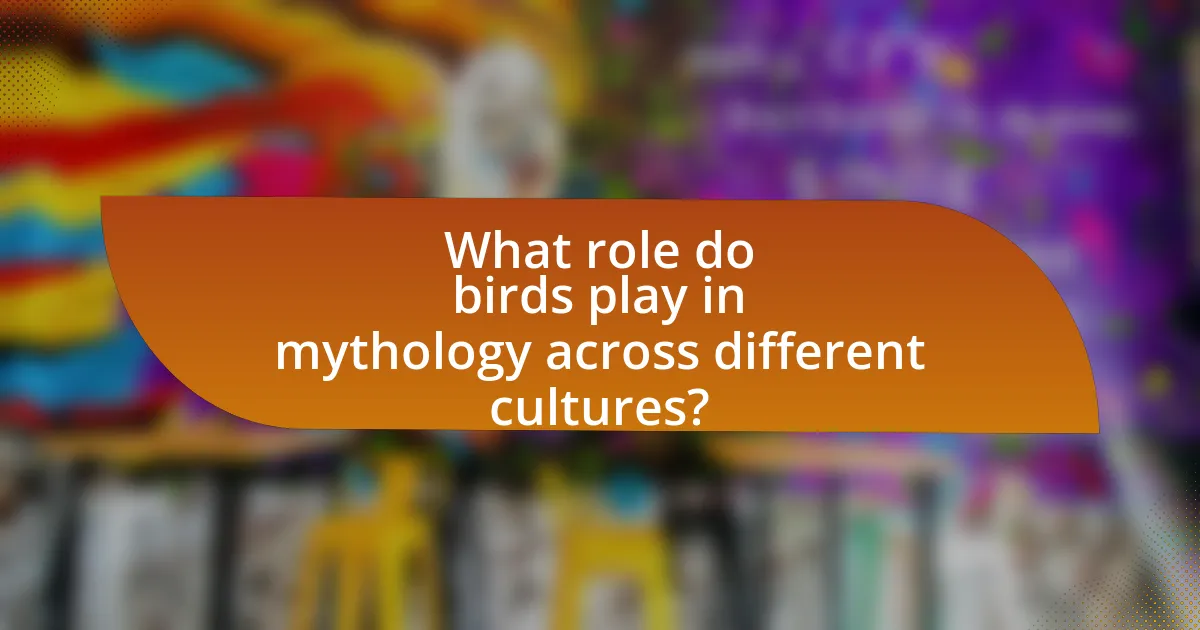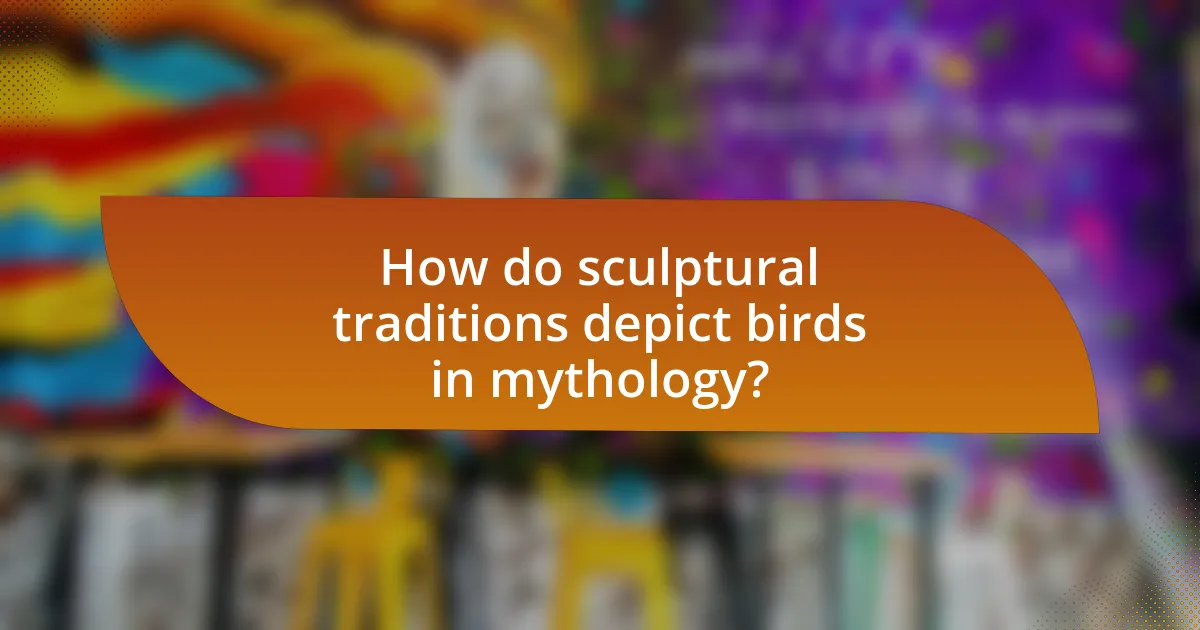The article examines the role of birds in mythology and their representations in global sculptural traditions. It highlights how birds symbolize concepts such as freedom, transcendence, and the connection between the earthly and divine across various cultures, including ancient Egyptian, Native American, and Greek mythologies. The discussion includes specific birds commonly featured in myths, their symbolic meanings, and the materials and techniques used in bird sculptures. Additionally, it explores themes of transformation and spirituality associated with birds, illustrating how these representations reflect cultural values and beliefs while providing insights for contemporary artists.

What role do birds play in mythology across different cultures?
Birds serve as significant symbols in mythology across various cultures, often representing concepts such as freedom, transcendence, and the connection between the earthly and the divine. In ancient Egyptian mythology, the falcon-headed god Horus symbolizes kingship and the sky, while in Native American traditions, the eagle is revered as a messenger to the spirit world and a symbol of strength. Similarly, in Greek mythology, the owl is associated with Athena, the goddess of wisdom, highlighting the bird’s role as a symbol of knowledge. These examples illustrate how birds embody diverse meanings and functions in mythological narratives, reflecting cultural values and beliefs.
How are birds symbolically represented in various mythologies?
Birds are symbolically represented in various mythologies as messengers, symbols of freedom, and embodiments of the divine. In ancient Egyptian mythology, the falcon represents the sky god Horus, symbolizing kingship and protection. In Greek mythology, the owl is associated with Athena, the goddess of wisdom, indicating knowledge and insight. Similarly, in Native American cultures, the eagle is revered as a spiritual messenger, representing strength and courage. These representations highlight the diverse roles birds play across different cultures, often linking them to human experiences and spiritual beliefs.
What specific birds are commonly featured in mythological stories?
Specific birds commonly featured in mythological stories include the phoenix, the raven, the owl, and the swan. The phoenix symbolizes rebirth and immortality in various cultures, such as in Greek and Egyptian mythology, where it is said to rise from its ashes. The raven often represents wisdom and prophecy, prominently appearing in Norse mythology as a companion to Odin. The owl is associated with knowledge and the goddess Athena in Greek mythology, symbolizing wisdom and protection. Lastly, the swan is frequently linked to beauty and transformation, as seen in tales like “The Ugly Duckling” and various folklore across cultures. These birds serve significant roles in conveying themes and morals within their respective mythologies.
How do the characteristics of birds influence their mythological roles?
The characteristics of birds significantly influence their mythological roles by embodying various symbolic meanings across cultures. For instance, the ability of birds to fly often represents freedom and transcendence, leading to their association with deities and spiritual messengers in many mythologies, such as the Greek god Hermes, who is depicted with wings. Additionally, birds’ diverse traits, such as the wisdom of owls or the beauty of peacocks, contribute to their roles as symbols of knowledge and beauty, respectively. This is evident in Native American mythology, where the eagle is revered as a powerful spiritual guide due to its keen vision and high flight. Thus, the unique characteristics of birds shape their representation in myths, reflecting human values and beliefs.
Why are birds significant in the creation myths of different societies?
Birds are significant in the creation myths of different societies because they often symbolize the connection between the earthly and the divine, representing freedom, transcendence, and the spirit. In many cultures, birds are depicted as messengers of the gods or as creators themselves, such as in the Native American myth of the “Great Spirit” who created the world with the help of a bird. Additionally, in ancient Egyptian mythology, the goddess Ma’at is often represented as a bird, embodying truth and order in the universe. These representations highlight the role of birds in conveying essential themes of life, creation, and the cosmos across various cultural narratives.
What are some examples of creation myths involving birds?
Creation myths involving birds include the Native American creation story of the “Sky Woman,” where a bird helps her descend to Earth, and the Egyptian myth of the “Phoenix,” which symbolizes rebirth and creation through fire. In the Hindu tradition, the “Hamsa” or swan is often depicted as a divine bird that carries the goddess Saraswati, representing knowledge and creation. Additionally, in the Maori culture, the “Kāhu” or harrier hawk is seen as a messenger of the gods, playing a role in the creation of the world. These examples illustrate the significant role birds play in various cultural narratives surrounding creation.
How do these myths reflect the values and beliefs of the cultures they originate from?
Myths about birds reflect the values and beliefs of their originating cultures by embodying their spiritual, social, and environmental perspectives. For instance, in many Indigenous cultures, birds symbolize freedom and connection to the divine, illustrating a belief in the interconnectedness of life. The Native American belief in the eagle as a messenger to the Creator highlights the value placed on spirituality and nature. Similarly, in ancient Egyptian mythology, the goddess Ma’at, often depicted with a bird, represents truth and cosmic order, emphasizing the cultural importance of justice and harmony. These examples demonstrate how avian myths serve as cultural touchstones, encapsulating the ideals and moral frameworks of the societies from which they emerge.

How do sculptural traditions depict birds in mythology?
Sculptural traditions depict birds in mythology as symbols of various attributes, including freedom, divinity, and transformation. In many cultures, birds are represented in sculptures to convey messages about the spiritual realm; for instance, in ancient Egyptian art, the falcon-headed god Horus symbolizes kingship and the sky. Similarly, in Native American traditions, eagles are often carved to represent strength and connection to the divine. These representations are not merely decorative; they serve to communicate cultural beliefs and values, as seen in the intricate carvings of birds in Hindu temples, where they symbolize the soul’s journey. The consistent portrayal of birds across different cultures highlights their significance in mythological narratives and their role in expressing human experiences and aspirations.
What materials are commonly used in bird sculptures across cultures?
Common materials used in bird sculptures across cultures include wood, stone, metal, clay, and glass. Wood is often favored for its availability and workability, allowing artisans to create intricate designs, as seen in Native American totem poles. Stone, such as marble or granite, is used for its durability and has been employed in ancient Egyptian sculptures. Metal, including bronze and copper, is utilized for its strength and ability to capture fine details, evident in various Asian and African artworks. Clay is commonly used in pottery and figurines, particularly in indigenous cultures, while glass is increasingly popular in contemporary art for its aesthetic qualities. Each material reflects the cultural significance and artistic traditions of the societies that produce these sculptures.
How do different materials affect the representation of birds in sculpture?
Different materials significantly influence the representation of birds in sculpture by affecting texture, form, and detail. For instance, wood allows for intricate carvings that can capture the delicate features of birds, while bronze enables a more durable and detailed representation, often used for larger sculptures that convey strength and permanence. Additionally, clay can be molded to create expressive forms, allowing for a more stylized interpretation of avian characteristics. Historical examples include the wooden totems of Indigenous cultures, which depict birds with cultural significance, and the bronze sculptures of birds in ancient Greek art, which emphasize realism and anatomical accuracy. These material choices not only shape the aesthetic qualities of the sculptures but also reflect the cultural meanings attributed to birds in various traditions.
What techniques are employed in creating bird sculptures?
Various techniques are employed in creating bird sculptures, including carving, modeling, casting, and assemblage. Carving involves shaping materials like wood or stone to depict avian forms, while modeling uses malleable substances such as clay to create detailed representations. Casting techniques, often involving metals or resins, allow for the reproduction of intricate designs, and assemblage combines different materials to form a cohesive bird sculpture. These methods have been utilized across cultures, reflecting the significance of birds in mythology and art, as seen in ancient Egyptian sculptures and contemporary installations.
What are some notable examples of bird sculptures in mythology?
Notable examples of bird sculptures in mythology include the Egyptian god Horus, often depicted as a falcon, symbolizing kingship and the sky. In Native American mythology, the Thunderbird is represented as a powerful bird sculpture, embodying strength and the ability to control the weather. Additionally, the Greek mythological figure of the Phoenix is frequently sculpted, representing rebirth and immortality through its cycle of burning and rising from ashes. These sculptures serve as significant cultural symbols, reflecting the beliefs and values of their respective societies.
Which cultures have the most famous bird sculptures?
The cultures with the most famous bird sculptures include Ancient Egyptian, Indigenous American, and Chinese cultures. Ancient Egyptians created iconic sculptures of birds, such as the falcon-headed god Horus, which symbolize protection and kingship. Indigenous American cultures, particularly the Pueblo and Navajo, produced intricate bird carvings that reflect their spiritual beliefs and connection to nature. Chinese culture is renowned for its detailed bird sculptures, especially in the context of traditional art, where birds like cranes symbolize longevity and good fortune. These examples illustrate the significance of avian representations across various cultures in their sculptural traditions.
How do these sculptures convey mythological narratives?
Sculptures convey mythological narratives through the depiction of avian figures that symbolize various deities, stories, and cultural beliefs. These representations often illustrate specific myths, such as the role of birds as messengers between the divine and human realms, as seen in ancient Egyptian sculptures of the falcon-headed god Horus. Additionally, the intricate details and poses of the birds in these sculptures can reflect the characteristics and attributes associated with the myths, reinforcing the narrative through visual storytelling. For example, the use of vibrant colors and dynamic forms in sculptures from Mesoamerican cultures often signifies the importance of birds in creation myths, showcasing their connection to life and fertility.

What themes emerge from the representation of birds in global sculptural traditions?
The representation of birds in global sculptural traditions reveals themes of freedom, spirituality, and transformation. Birds often symbolize freedom due to their ability to fly, which is reflected in various cultures where they represent the human desire for liberation. For instance, in Native American traditions, birds are seen as messengers between the earthly and spiritual realms, emphasizing their spiritual significance. Additionally, the theme of transformation is prevalent, as birds frequently embody change and rebirth, evident in sculptures depicting mythical creatures like the phoenix in various cultures. These themes are consistently reinforced across different global traditions, showcasing the universal significance of birds in human expression and belief systems.
How do birds symbolize transformation and transcendence in mythology?
Birds symbolize transformation and transcendence in mythology by representing the journey between the earthly and the divine. In various cultures, birds are often seen as messengers between realms, facilitating spiritual growth and change. For example, in ancient Egyptian mythology, the soul is depicted as a bird, signifying rebirth and the transition to the afterlife. Similarly, in Native American traditions, the eagle is revered as a symbol of spiritual power and connection to the Creator, embodying the idea of rising above earthly limitations. These representations highlight the role of birds as symbols of hope, renewal, and the potential for personal and spiritual evolution.
What are some myths that illustrate this theme through bird representations?
Myths that illustrate the theme of birds in mythology include the Greek myth of the Phoenix, which symbolizes rebirth and immortality, and the Native American legend of the Thunderbird, representing power and strength. The Phoenix is known for rising from its ashes, embodying the cycle of life and death, while the Thunderbird is often depicted as a powerful spirit that controls the weather and is a protector of the people. These representations highlight the cultural significance of birds as symbols of transformation and divine intervention across various traditions.
How do these themes resonate with contemporary audiences?
Themes of avian representations in mythology resonate with contemporary audiences by reflecting universal human experiences and emotions, such as freedom, transformation, and the connection between the earthly and the divine. These themes are relevant today as they address the ongoing human quest for meaning and identity, often symbolized by birds in various cultures. For instance, the symbolism of birds as messengers or symbols of hope can be seen in modern literature and art, where they often represent aspirations and the desire for transcendence. This connection is supported by studies showing that mythological themes continue to influence contemporary storytelling and artistic expression, highlighting their enduring significance in human culture.
What lessons can we learn from the avian representations in mythology?
Avian representations in mythology teach us about the interconnectedness of nature and humanity, as birds often symbolize freedom, transformation, and the spiritual realm. For instance, in various cultures, birds like the phoenix represent rebirth and renewal, illustrating the cyclical nature of life. Additionally, the presence of birds in myths often reflects human aspirations and fears, such as the desire for transcendence or the caution against hubris, as seen in the Icarus myth where wings made of feathers lead to downfall. These lessons highlight the importance of respecting natural forces and understanding our place within the broader ecosystem.
How can understanding these representations enhance our appreciation of cultural diversity?
Understanding avian representations in global sculptural traditions enhances our appreciation of cultural diversity by revealing how different cultures interpret and symbolize birds within their mythologies. These representations often reflect unique cultural values, beliefs, and environmental contexts, showcasing the diversity of human experience. For instance, in many Indigenous cultures, birds symbolize freedom and spirituality, while in other traditions, they may represent specific deities or natural phenomena. By studying these varied interpretations, individuals can gain insights into the distinct worldviews and historical narratives of different cultures, fostering a deeper respect and appreciation for cultural diversity.
What practical insights can artists gain from studying bird sculptures in mythology?
Artists can gain practical insights into symbolism, cultural narratives, and design techniques by studying bird sculptures in mythology. Bird sculptures often embody specific traits associated with various cultures, such as freedom, wisdom, or transformation, which can inform an artist’s understanding of how to convey complex themes through their work. For instance, the Egyptian god Horus, depicted as a falcon, symbolizes kingship and the sky, illustrating how artists can utilize avian imagery to represent power and divinity. Additionally, analyzing the craftsmanship and stylistic choices in historical bird sculptures can enhance an artist’s technical skills and inspire innovative approaches to form and texture in their own creations.


